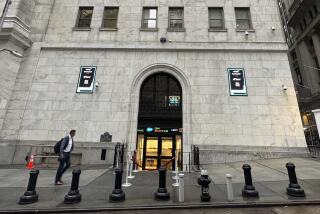Signs of vigor boost stocks
Stocks surged Tuesday on signs of resilience in the housing market and the U.S. consumer, with falling oil prices giving investors an extra reason to rally. The Dow Jones industrials gained more than 120 points to reach a five-week high.
The National Assn. of Realtors’ index for pending sales of existing homes rose in February at a seasonally adjusted annual rate of 0.7%. The index is well below where it was a year ago but stronger than investors expected, reassuring them that the housing sector, although weak, is not being pummeled by the struggling sub-prime mortgage sector.
Fears that lending problems will spill over into the rest of the economy have been a major factor behind the market’s volatility of the last several weeks. The uptick in home sales was slight but came as a pleasant surprise to investors who had been bracing for the worst.
“That says people are getting mortgages, people are buying houses, people have incomes, jobs, all that good stuff,” said Kim Caughey, equity research analyst at Fort Pitt Capital Group. “You’d never go out and buy a house if you think you’re going to get laid off. Consumers are optimistic about the future, and as we all know, the consumer drives this economy.”
Other data Tuesday also suggested that the American consumer was strong: A report from Redbook Research showed that consumers spent more at chain stores in March than they did in February, and Toyota Motor reported a steep increase in U.S. sales in March. Other vehicle sales reports issued Tuesday showed that Toyota continued to outperform U.S. automakers.
A decline in oil prices, waning as tensions eased between Britain and Iran, also encouraged investors. High energy prices contribute to inflation, which can crimp spending and hurt the chance of lower interest rates.
The Dow rose 128 points, or 1%, to 12,510.30 -- its highest close since Feb. 26, the day before it made its 416-point plunge. The blue-chip index is back in positive territory for the year and 276 points below its record close of 12,786.64 on Feb. 20.
Broader stock indicators also soared. The Standard & Poor’s 500 index gained 13.22 points, or 0.9%, to 1,437.77, and the Nasdaq composite index added 28.07 points, or 1.2%, to 2,450.33.
The Russell 2,000 index of smaller companies rose 8.55, or 1.1%, to 811.77.
Bond yields rose after the release of the home-sales data, with the yield on the benchmark 10-year Treasury note climbing to 4.67% from 4.64% on Monday.
Crude oil futures dropped more than a dollar to $64.64 a barrel on the New York Mercantile Exchange. Prices had surged when 15 British sailors and marines were detained March 23 by Iran, but the two nations were in talks that appeared to be bringing the captives closer to release.
Airline stocks climbed on the prospect of declining fuel costs as well as a rise in Continental Airlines’ passenger revenue. Continental rose $3.03, or 8.4%, to $39.08.
Meanwhile, March auto sales showed weakness among U.S. automakers. General Motors, Ford Motor and DaimlerChrysler all reported that U.S. sales fell, while Japan-based automakers Toyota, Honda Motor, and Nissan Motor saw theirs rise.
GM rose 64 cents to $31.47 after reporting an increase in China sales. Ford fell a penny to $8.08 and Daimler Chrysler fell $1.07 to $82.95.
U.S. shares of Toyota, which is closing in on Ford to become the United States’ No. 2 automaker, rose 6 cents to $126.98. Nissan’s U.S. shares rose 2 cents to $21.56 and Honda’s rose 80 cents to $35.49.
Advancing issues outnumbered decliners by about 3 to 1 on the New York Stock Exchange, where consolidated volume came to 2.9 billion shares, up from 2.8 billion shares Monday. It’s a four-day workweek for most of Wall Street; stock markets will be closed for Good Friday.
The home-sales report, the primary catalyst driving up stocks Tuesday, was not especially robust, but the market has been hungry for some decent news on the housing front to suggest that the broader economy is impervious to the financial problems of sub-prime lenders, companies that make loans to people with poor credit.
Although Tuesday’s stock gains were strong, the market remains vulnerable. The sub-prime lending market is still shaky, and earnings season is less than two weeks away.
“I don’t think we’re out of the woods yet,” said John O’Donoghue, co-head of equities at Cowen & Co., noting that some of the market’s gains were probably a result of frustrated traders short-covering, or buying back bets that prices would fall. “The market has exhibited a certain amount of complacency. We’ll see how earnings come in.”
Investors are treading fairly optimistically toward the first-quarter earnings-reporting season.
“When economies are softer than anticipated, companies get a lot of negative surprises. It’s way too early to say this definitely, but perhaps the economy isn’t slowing as rapidly as envisioned,” Fort Pitt Capital’s Caughey said.
More to Read
Inside the business of entertainment
The Wide Shot brings you news, analysis and insights on everything from streaming wars to production — and what it all means for the future.
You may occasionally receive promotional content from the Los Angeles Times.










